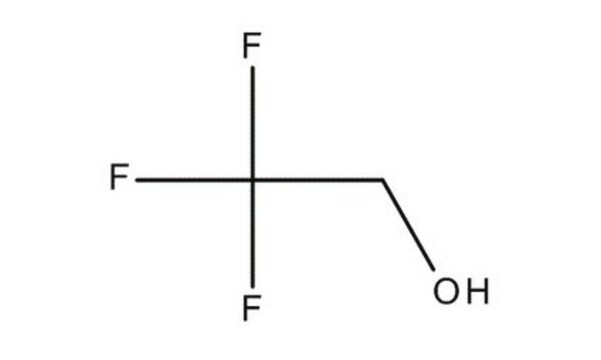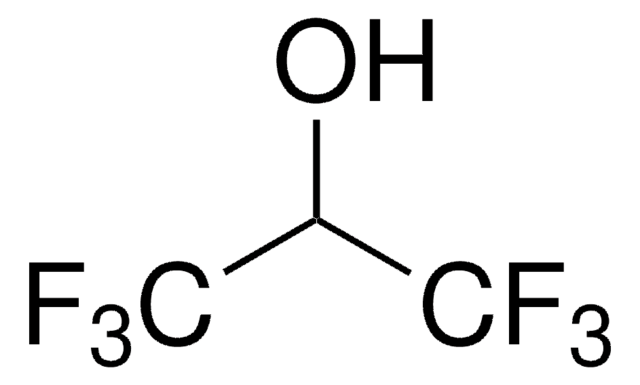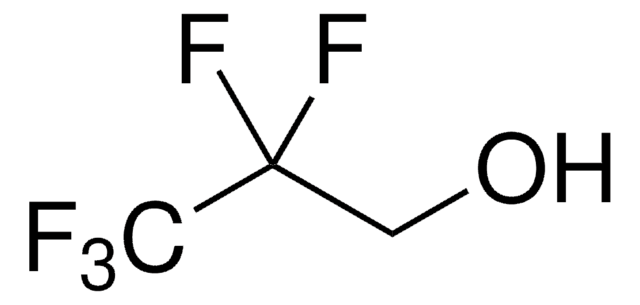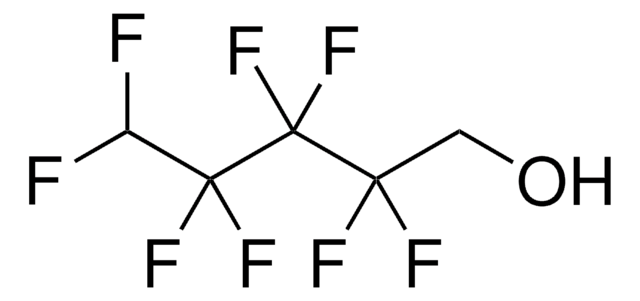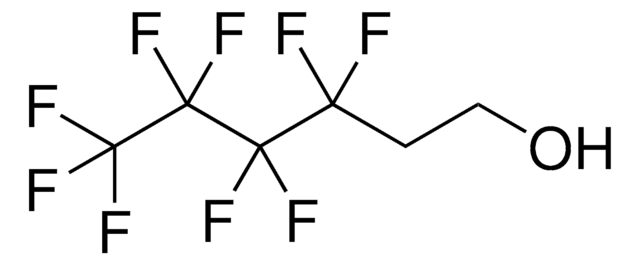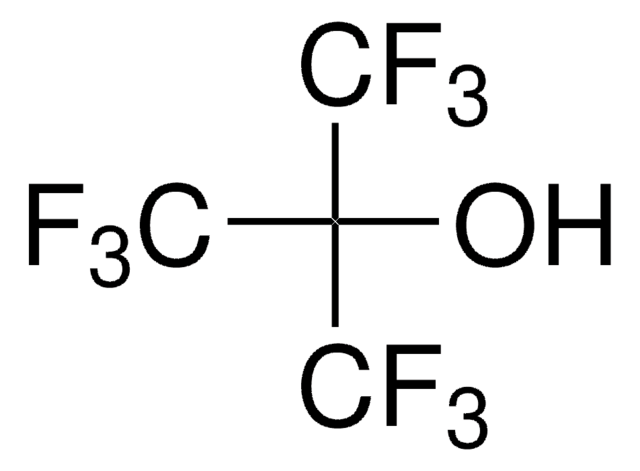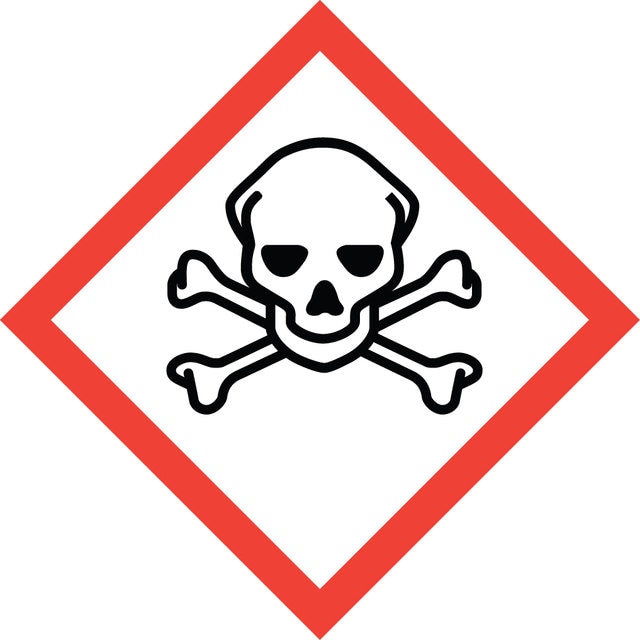모든 사진(1)
About This Item
Linear Formula:
CF3CH2OH
CAS Number:
Molecular Weight:
100.04
Beilstein:
1733203
EC Number:
MDL number:
UNSPSC 코드:
12191601
PubChem Substance ID:
NACRES:
NA.21
bp:
77-80 °C (lit.)
vapor pressure:
70 mmHg ( 25 °C)
추천 제품
vapor density
3.5 (vs air)
Quality Level
vapor pressure
70 mmHg ( 25 °C)
제품 라인
ReagentPlus®
분석
≥99%
양식
liquid
autoignition temp.
~896 °F
expl. lim.
42 %
dilution
(for general lab use)
refractive index
n20/D 1.3 (lit.)
pH
7
bp
77-80 °C (lit.)
mp
−44 °C (lit.)
density
1.373 g/mL at 25 °C (lit.)
SMILES string
OCC(F)(F)F
InChI
1S/C2H3F3O/c3-2(4,5)1-6/h6H,1H2
InChI key
RHQDFWAXVIIEBN-UHFFFAOYSA-N
유사한 제품을 찾으십니까? 방문 제품 비교 안내
일반 설명
2,2,2-Trifluoroethanol (TFE) is an organic compound with the chemical formula CF3CH2OH. TFE is a commonly used solvent in organic synthesis. It can also be used as a cosolvent in the experimental study of proteins and peptides.
애플리케이션
2,2,2-Trifluoroethanol can be used as a solvent:
- In the synthesis of 2-amino-3-cyano-4H-chromene and tetrahydrobenzo[b]pyran derivatives by catalyst free one-pot condensation of aldehydes, malononitrile and resorcinol or dimedone.
- In the N-formylation of amines with formic acid in the presence of heterogeneous ZIF-8 (zeolitic imidazolate framework) catalyst.
- In the preparation of 2-substituted-2,3-dihydro-4(1H)-quinazolinone derivatives by condensation of anthranilamide with alkyl, aryl, or heteroaryl ketones or aldehydes.
- In the mild and selective oxidation of sulfur compounds using H2O2(hydrogen peroxide).
특징 및 장점
2,2,2-Trifluoroethanol is more acidic than ethanol due to the presence of electronegative trifluoromethyl group.
법적 정보
ReagentPlus is a registered trademark of Merck KGaA, Darmstadt, Germany
신호어
Danger
유해 및 위험 성명서
Hazard Classifications
Acute Tox. 3 Inhalation - Acute Tox. 3 Oral - Eye Dam. 1 - Flam. Liq. 3 - Repr. 1B - STOT RE 2 Inhalation
표적 기관
Blood
Storage Class Code
3 - Flammable liquids
WGK
WGK 1
Flash Point (°F)
86.0 °F - closed cup
Flash Point (°C)
30 °C - closed cup
가장 최신 버전 중 하나를 선택하세요:
이미 열람한 고객
Hannah A Strobel et al.
Tissue engineering. Part A, 24(19-20), 1492-1503 (2018-05-05)
Tissue-engineered human blood vessels may enable in vitro disease modeling and drug screening to accelerate advances in vascular medicine. Existing methods for tissue-engineered blood vessel (TEBV) fabrication create homogenous tubes not conducive to modeling the focal pathologies characteristic of certain
Erin K Zess et al.
PLoS biology, 17(7), e3000373-e3000373 (2019-07-23)
Autophagy-related protein 8 (ATG8) is a highly conserved ubiquitin-like protein that modulates autophagy pathways by binding autophagic membranes and a number of proteins, including cargo receptors and core autophagy components. Throughout plant evolution, ATG8 has expanded from a single protein
Bei Feng et al.
Biomacromolecules, 13(12), 3917-3925 (2012-11-08)
In tissue engineering research, there has recently been considerable interest in using electrospun biomimetic nanofibers of hybrids, in particular, from natural and synthetic polymers for engineering different tissues. However, phase separation between a pair of much dissimilar polymers might give
A facile parallel synthesis of trifluoroethyl-substituted alkynes.
Cui-Bo Liu et al.
Angewandte Chemie (International ed. in English), 51(25), 6227-6230 (2012-05-09)
Catherine Pan et al.
Journal of proteome research, 13(11), 4535-4545 (2014-05-24)
Despite extensive research, an unmet need remains for protein biomarkers of Parkinson's disease (PD) in peripheral body fluids, especially blood, which is easily accessible clinically. The discovery of such biomarkers is challenging, however, due to the enormous complexity and huge
자사의 과학자팀은 생명 과학, 재료 과학, 화학 합성, 크로마토그래피, 분석 및 기타 많은 영역을 포함한 모든 과학 분야에 경험이 있습니다..
고객지원팀으로 연락바랍니다.